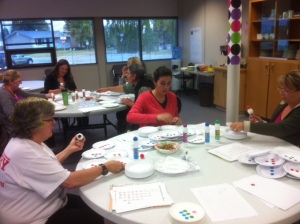 This week some of the teachers in the district attended a workshop held here at the SD#60 board office. Our focus for the session was early numeracy, in particular, number relationships that are important for young learners. We focused on these “big four” relationships:
This week some of the teachers in the district attended a workshop held here at the SD#60 board office. Our focus for the session was early numeracy, in particular, number relationships that are important for young learners. We focused on these “big four” relationships:
• One more/one less (extending to two more/two less)
• Visual/spatial relationships
• The benchmarks or anchors of 5 and 10
• Whole-part-part
I particularly refer to the whole-part-part relationship in that manner (as opposed to part-part-whole often used by others). I like stating “whole” first because the emphasis of that relationship is that a number can be pulled apart into two smaller parts, not the joining together of two parts to make a larger whole. This distinction is not just a matter of semantics, but rather a spotlighting of the pulling apart. “To conceptualize a number as being made up of two or more parts is the most important relationship that can be developed about numbers” (Van de Walle, 2005).
Understand that there is a lot of counting that must take place as children work to build these relationships. They must repeatedly work with counters as well as dice, dominoes, ten frames, dot cards, dot plates, and other things that show patterned arrangements of numbers to build a deep understanding about the numbers, first 1-10, then extending to 20, to 100 and beyond.
The workshop participants went home with a set of dot plates they made from small paper plates and bingo daubers (see photo). They also took home 4 sets of small dot cards printed on colourful cardstock. Lastly they took away larger paper plates with dot patterns on them (the patterns from either mini dot cards or mini ten frames) that could become spinners for games or made into activities for math centres.
One other tool that we talked about was a grid of tools that both the teacher and students could use for representing numbers. When one looks at the grid and possible combinations of materials, it is easy to see that having a few good tools on hand allows for many different ways for young children to be involved in representing number.
Download the Representing Number Grid here.
 Download the dot card spinner here.
Download the dot card spinner here.
Download the ten frame spinner here. 
I hope you will think deeply about the ways you are having your young learners interact with numbers! You are laying the foundation for later mathematical learning.
Mathematically yours,
Carollee
PS My apologies to the participants — I had intended to post this blog by the end of last week and did not get to it, and over the weekend I did not have access to the visuals I wanted to post with it. So, hopefully, this is a case of better late than never!
Reference
Van de Walle, J. and Folk, S. (2005). Elementary and Middle School Mathematics: Teaching Developmentally (Canadian Edition). Pearson: Toronto.
